Streaming with the Wizard
Software name : VLC
Software version : 0.8.6
VLC makes the process of streaming quite easy by supplying a wizard. This particular method means that VLC itself is the streaming encoder and server. Hence you can encode and deliver the content from one machine. This can be very useful for streaming within a Local Area Network (LAN), however it is not very effective for streaming on the internet unless you have a Dedicated IP. This is because other machines will not be able to 'find' your stream from outside the local network unless your computer has a Dedicated IP Number.
Streaming with VLC in this way however does allow for interesting options for streaming material from cameras, pre-recorded files, or even DVDs. You can also relay other live streams and converting them to another format as you do it.
Opening the Wizard
First thing you need to do is open the wizard from the VLC interface:
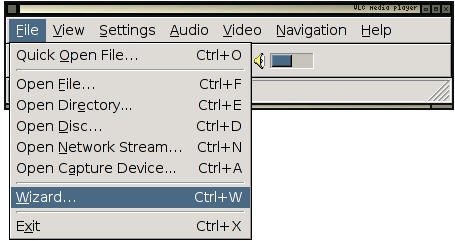
This will open the Wizard interface. If all is well it should appear and look somehting like this:

You will now need to choose the Stream to netowrk option:
![]()
Now press Next >
Choose Input
If all is well the following dialog will have appeared:
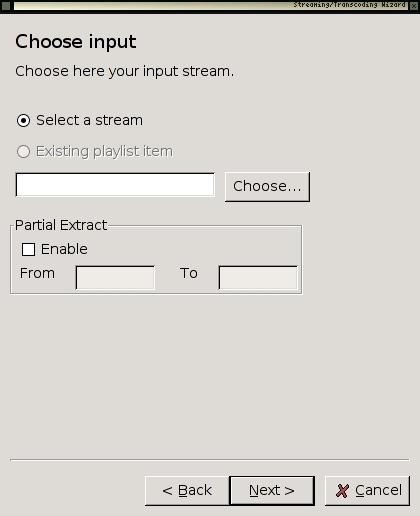
Now click on Choose and you will see a dialog that will show you options for choosing the input.
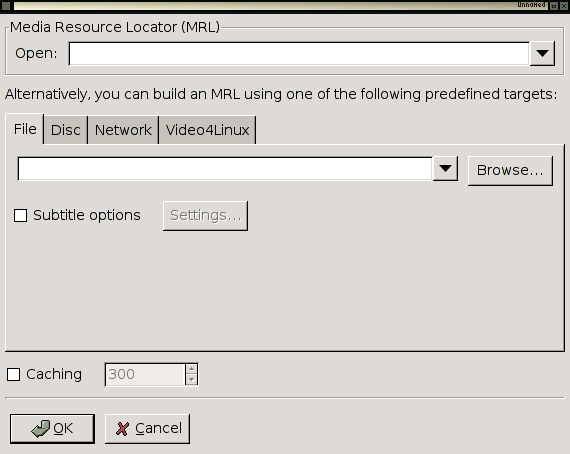
You can choose many options for stream inputs. In the following we will choose a file from our harddisk to stream. To choose a file you will need to first press Browse. A file browser will appear and you can use this to browse your harddisk and choose the file you wish to stream. In the following example the file we will use is called gaialive050318_tennis-live.mov.ogg
The location of this example file is displayed in the wizard when I have chosen it:

Note : it is a good idea to have first played the media you wish to stream to make sure VLC can actually play it.
Now press OK and proceed with configuring your stream.
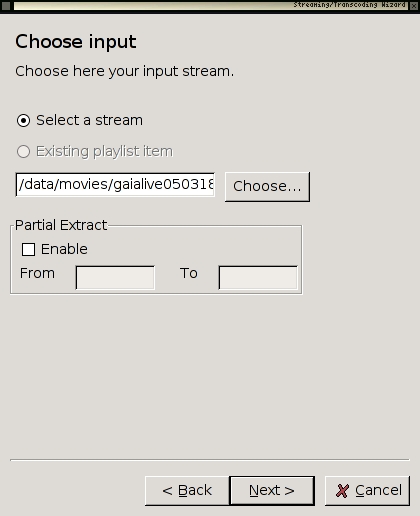
Now press Next >
Choose Streaming Method
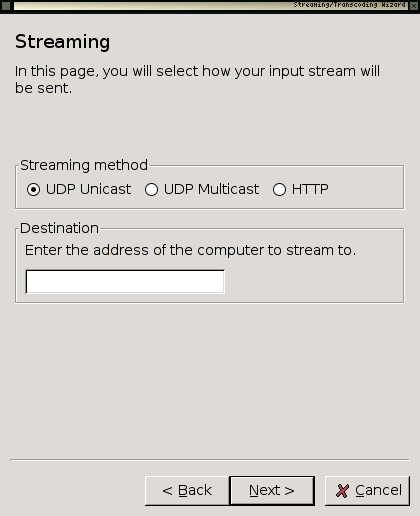
We will choose http as the streaming method. This means that the VLC application will act as a server as well as a media player. Other players can then connect to your computer and also watch the stream.
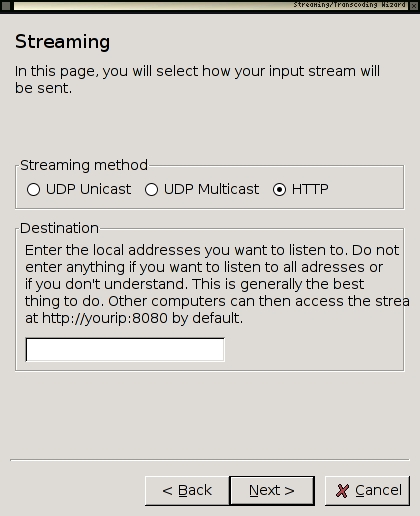
Now you need to just press Next >
Encapsulate Method
Now you need to choose what type of stream (format) you will send. The choices presented to you in this window will be formed from the modules you have installed so they may appear different from the following:
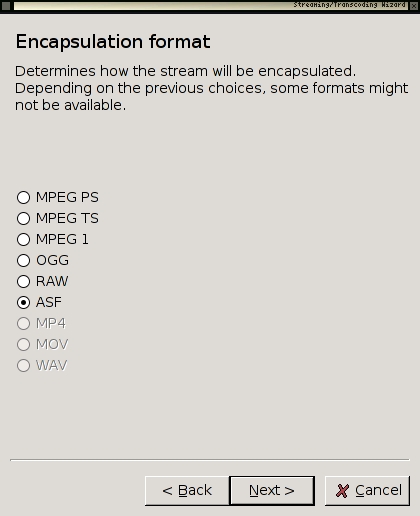
I am going to choose OGG as the encapsulation method, this means my video for the stream will be OGG THEORA and the audio will be OGG VORBIS. The encapsulation method (stream format) does not have to be the same as the file that you have loaded to stream. So, I choose OGG with the select button:
![]()
Additional Options

There is nothing you need to worry about on this screen. Just hit Finish and you will start streaming.
Checking the Stream is Working
If all is well VLC will give you some feedback to say it is streaming. You won't actually be able to see the content played back as it is streamed unless you do it through another player. However VLC itself should look somehting like this if all is well:

You can there is a timeline at the bottom of the player which should be moving, and there will be feedback in the bottom 'status' bar of the player saying Streaming/Transcoding. If you see neither of these then all is not well. To get more feedback choose the Messages dialog from the View menu:

Now you should see a window with better feedback:
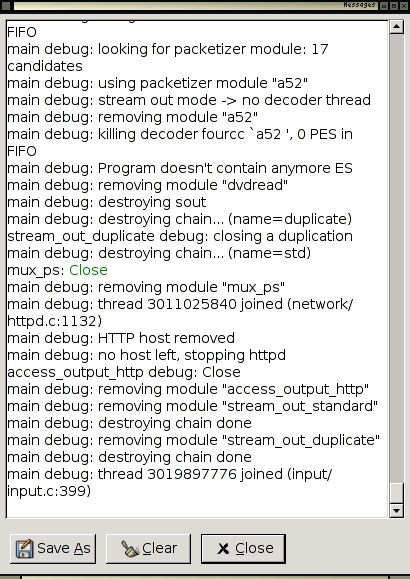
You can use this infomration to help trouble shoot. I recommend first using a search engine to copy and paste the error message (error messages will be highlighted in red in the message window). If you can't find anything through a search engine then try the VLC forums ( http://forum.videolan.org/ ). You can also try the irc (chat) room where a lot of the developers hang out. If you know how to use irc they can be located at :
- IRC network:
irc.freenode.net - Channel:
#videolan
If you done know how to use irc then try this web based version:
http://krishna.videolan.org/cgi-bin/irc/irc.cgi
Playing your Streams
If you have followed everything above and you seem to be streaming now is the time to try and playback the material. You can do this with a player the supports the Encapsulation Format that you chose. In the above example OGG was the chosen format, so I will need to play back the content in a player that supports OGG Theora and OGG Vorbis. I also need to know the location (URL) of my stream. The URL will be in the format:
http://yourip:8080/
Where yourip is the IP Number of your computer. If you don't know this then you need to find it out by reading about how to read the network settings on your operating system. If you don't know your IP Number then you can possibly test your stream by opening a player on the same machine as the one you are using to send the stream and using this URL:
http://localhost:8080/
You need to use your favourite player, open it and enter the above in the Open Location (or other) field. If all is well the stream will play back.
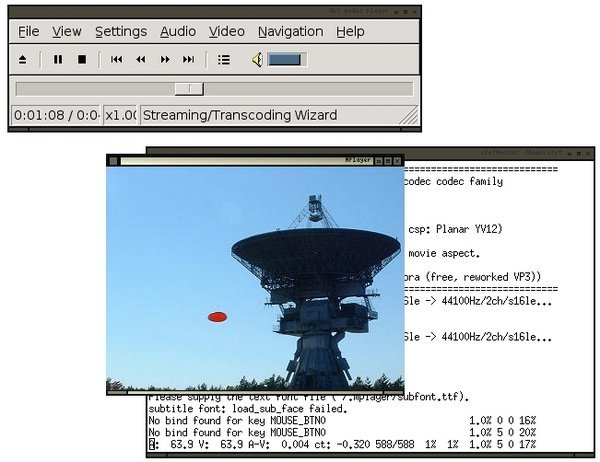
The above image shows VLC streaming and the playback of the video in mplayer on the same machine.





